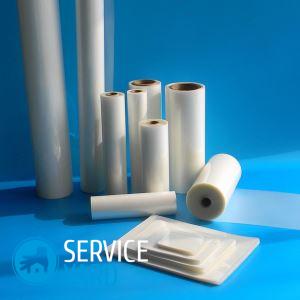Lamination of paper 🥝 how to laminate at home with an iron, cling film

Very often there are situations when paper documents must always be with you. Accordingly - the material is overwritten, thinned, and the desired leaflet does not look so presentable. In especially neglected cases, the information indicated in such a document may also be erased, therefore, efforts must be made in advance to preserve it. The topic of today's article is: how to laminate paper at home. The master class presented in the article is also excellent for extending the “life” of development cards, which are used in classes with children.
to contents ↑DIY lamination with a special film
What to do if there is no laminator at home? This method is one of the simplest and most reliable; here you can do without a laminator. Two things will be required for this:
- iron;
- special film.
As practice shows, the most convenient for work is A4 size.
The thickness of the laminating membrane is 75-200 microns:
- To laminate documents at home, it is advisable to choose a product thicker.
- For children's cards, a thickness of 75-80 microns is enough.
Important! The cost of the film is quite high, and there are a lot of cards in the development sets. To save a little, you can pre-stick them on cardboard, and then use thinner, and therefore cheaper, material.
The shell is made of matte material, has the appearance of a "pocket" connected on one side horizontally or vertically (depending on the manufacturer). The inside of the “pocket” is coated with a bonding agent that, when heated, connects the paper to the film. This is the essence of the lamination process
How to laminate paper at home?
- Set the average heating temperature on the iron - a little less than the "deuce".
Important! If the sole of the iron is cold, the process will not succeed, if it is too hot, then the surface will take “bubbles”.
- Put the sheet inside the “pocket” and start ironing from the joint to the edges to expel the air from the inside. When heated, the matte material becomes transparent. As it cools, the material becomes solid.
Important! You should not be afraid that the film will stick to the sole of the iron. This can happen if you think of turning the “envelope” inside out. But if you still want to play it safe, smooth the film through a clean, dry cloth or white paper sheet.
Sometimes when ironing, an air bubble forms:
- Try to smooth the material, smooth it with a soft cloth.
- If this does not help, pierce the bubble with a needle, and then smooth the area with an iron.
- To cut off excess, use a ruler and a clerical knife. With rounded areas it is convenient to work with nail scissors.
How to laminate paper at home? Alternatives
Of course, the use of a special laminating membrane is the best way. But what if the special material was not on sale, and the lamination of documents or pictures is needed? There are alternatives.
Wide tape
Working with scotch tape requires certain skills. Either it sticks together, or strives to stick to the surface in a completely different way.Sometimes ugly air bubbles form underneath. But with patience, perseverance and skill at work, you can use scotch tape to laminate small cards.
Hot glue film
The principle of operation is the same as with conventional laminating material. Apply film on top of the paper and iron it through a white sheet of paper. It turns out very well.
Self-adhesive film for glasses
As a rule, it is issued with drawings, but there is also a transparent one. It sticks well enough.
Book wrapper
You will need book covers with an adhesive layer. Cut a piece of the right size, remove the protective layer and gently stick it on paper.
to contents ↑Stock footage
We hope that the above methods of laminating with your own hands will be useful to you.
- How to choose a vacuum cleaner taking into account the characteristics of the house and coatings?
- What to look for when choosing a water delivery
- How to quickly create comfort at home - tips for housewives
- How to choose the perfect TV - useful tips
- What to look for when choosing blinds
- What should be running shoes?
- What useful things can you buy in a hardware store
- Iphone 11 pro max review
- Than iPhone is better than Android smartphones



